1. Cephalic setae indistinct
or absent . 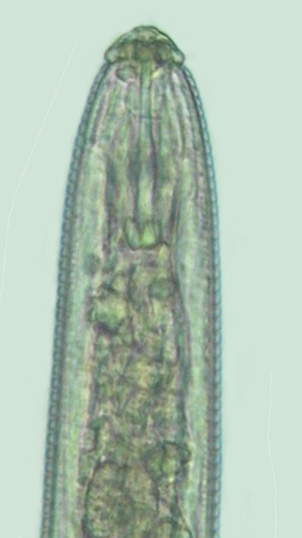 ..2
Cephalic setae absent but setae-like
head appendages present . ..2
Cephalic setae absent but setae-like
head appendages present .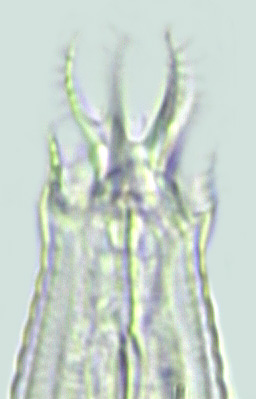 .
64
Cephalic setae present . .
64
Cephalic setae present .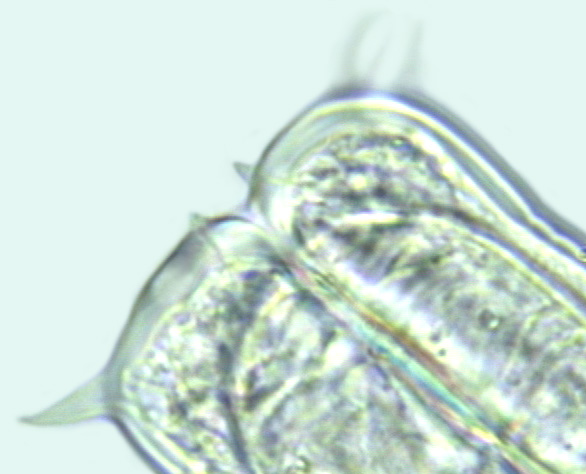 ..69 ..69
|
2. (1) Stylet present
.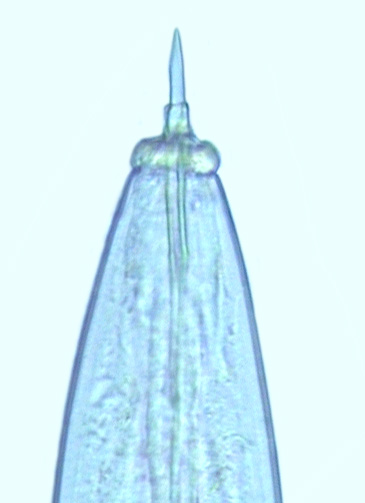 .3
Stylet absent .3
Stylet absent 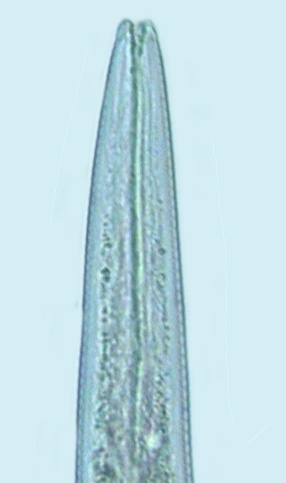 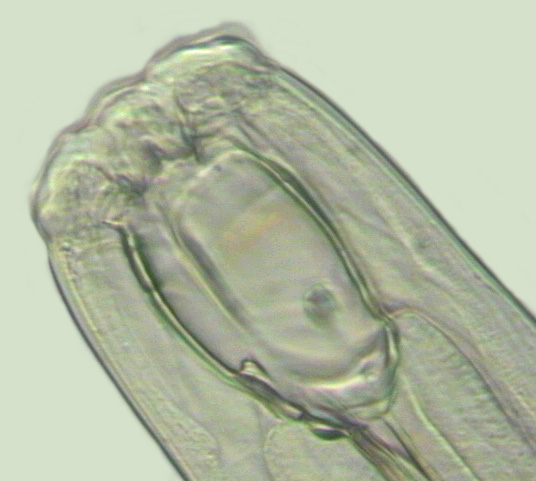 ..38 ..38
|
3. (2) Base of stylet
knobbed or flanged .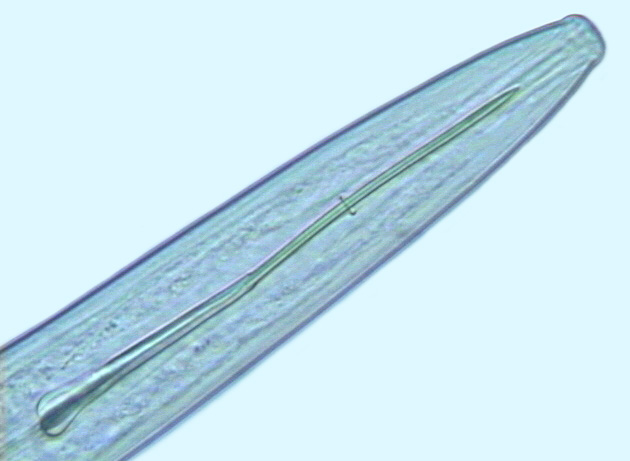 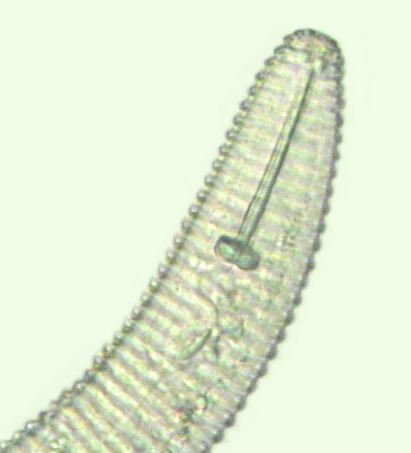 .4
Stylet knobs or flanges absent
.. .4
Stylet knobs or flanges absent
..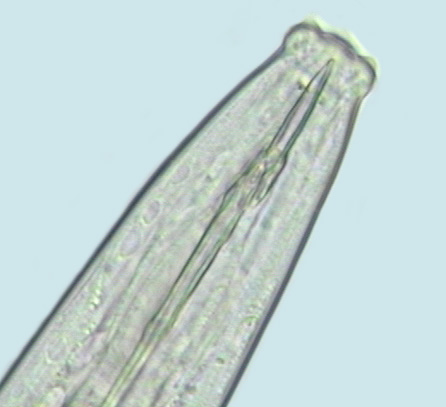 .29 .29
|
4. (3) Valvate median
esophageal bulb present .. .5
Valvate median esophageal bulb
absent .5
Valvate median esophageal bulb
absent ...22
...22
|
5. (4) Females eel-like
. ..........6
Females swollen . ..........6
Females swollen . ..21 ..21
|
6. (5) Vulva at mid-body
.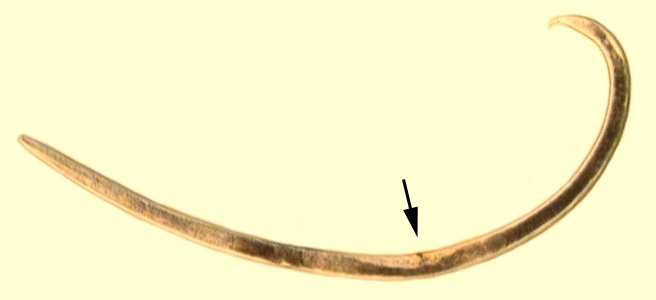 ....7
Vulva on lower third of body
. ....7
Vulva on lower third of body
.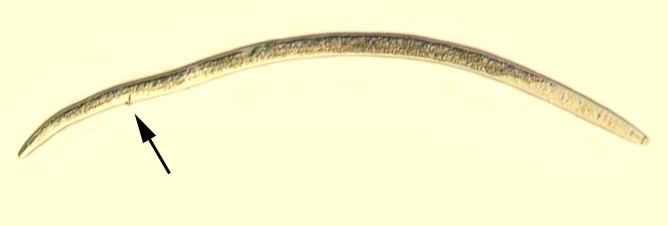 ...14 ...14
|
7. (6) Esophagus
not overlapping intestine .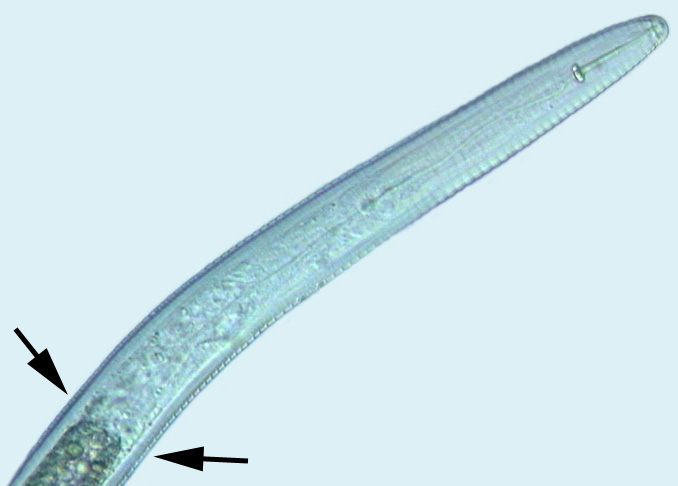 ....8 ....8
Esophagus overlapping intestine
.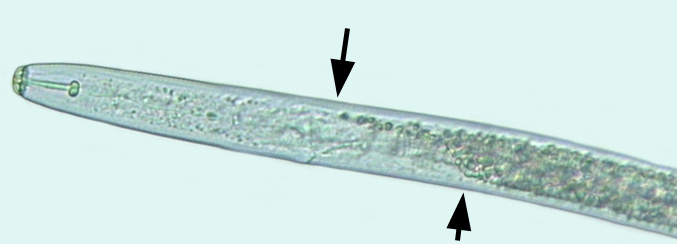 ....11 ....11
|
8. (7) Stylet length
less than 50 microns 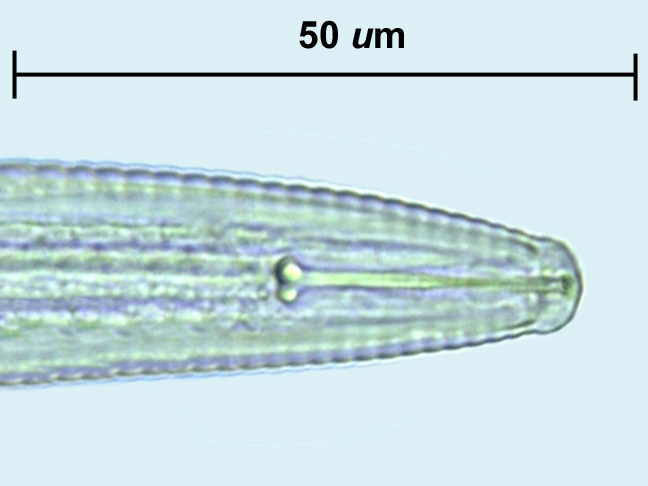 .....9
Stylet lenght greater than 80
microns . .....9
Stylet lenght greater than 80
microns .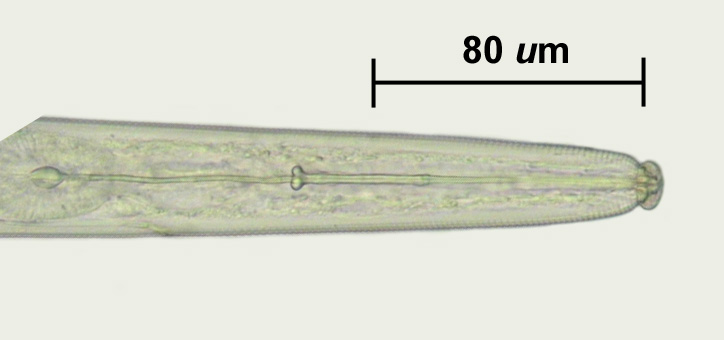 .....
Dolichodorus .....
Dolichodorus
|
9. (8) Tail terminus
bluntly pointed 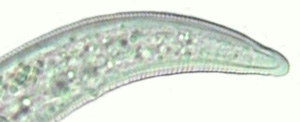 .....Quinisulcius
Tail terminus not pointed .....Quinisulcius
Tail terminus not pointed 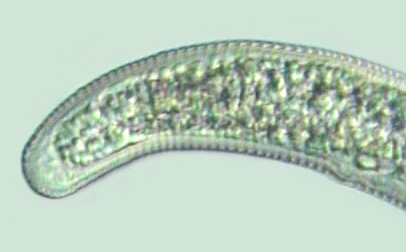 .....10 .....10
|
10. (9) Tail terminus
knobbed  ...
Psilenchus
Tail terminus never knobbed
or pointed . ...
Psilenchus
Tail terminus never knobbed
or pointed .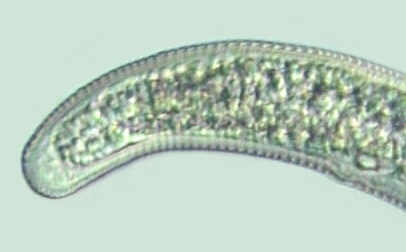 ..
Tylenchorhynchus,
Merlinius,
Geocenamus (in part),
Scutylenchus,
Nagelus ..
Tylenchorhynchus,
Merlinius,
Geocenamus (in part),
Scutylenchus,
Nagelus
|
11.
(7) Labium offset .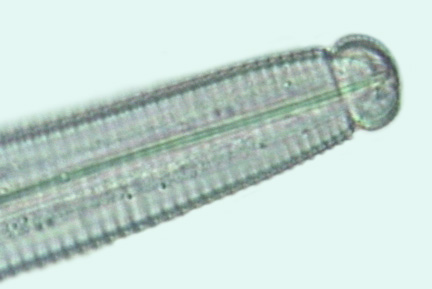 ...12
Labium flattened amalgamated
or nearly so . ...12
Labium flattened amalgamated
or nearly so .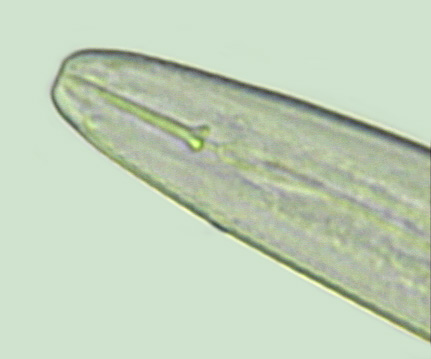 . .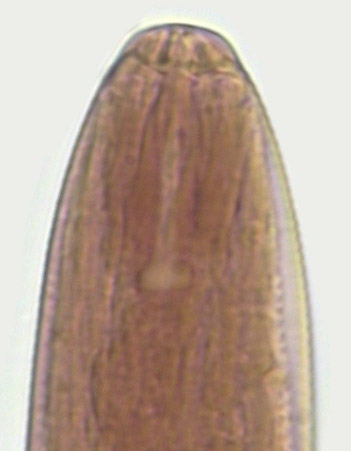 ....13 ....13
|
12. (11) Stylet massive,
40-50 microns long 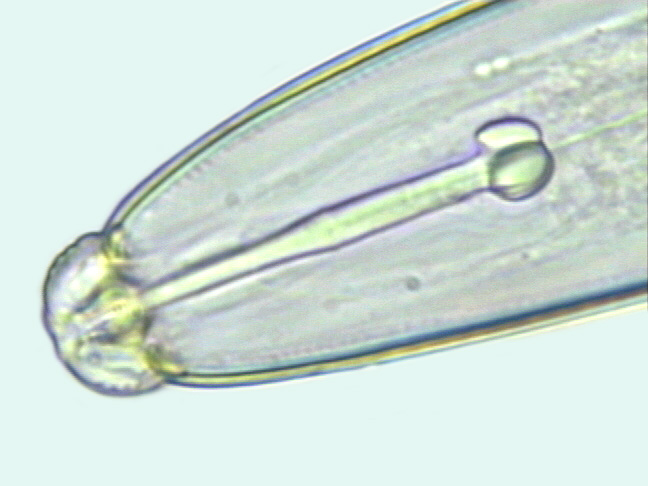 ..
Hoplolaimus
Stylet long and thin, greater
than 90 microns long . ..
Hoplolaimus
Stylet long and thin, greater
than 90 microns long . ..
Belonolaimus ..
Belonolaimus
|
13. (11) Body 0.5-1
mm . .....
Radopholus
Body 2-3 mm long ..... Hirshmaniella .....
Radopholus
Body 2-3 mm long ..... Hirshmaniella
|
14.
(6)
Cuticle heavily annulated, stylet elongate .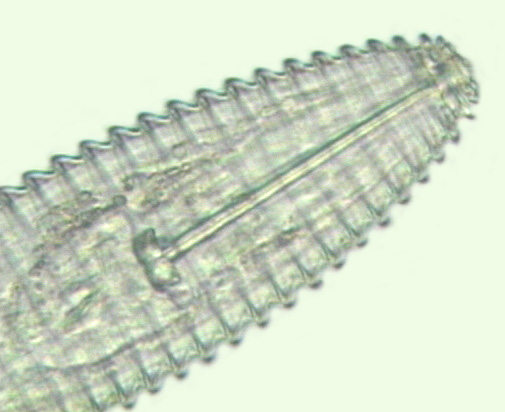 .15
Cuticle not heavily annulated,
stylet short . .15
Cuticle not heavily annulated,
stylet short .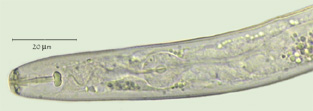 ....17
Cuticle not heavily annulated,
stylet long... ....17
Cuticle not heavily annulated,
stylet long...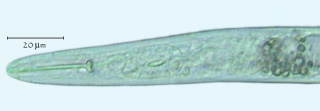 ..........Paratylenchus ..........Paratylenchus
|
15. (14) Cuticular
sheath absent .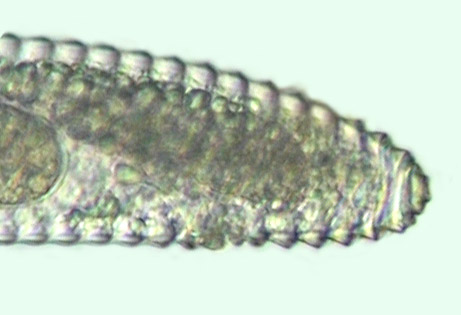 ..
16
Cuticular sheath present ..
16
Cuticular sheath present 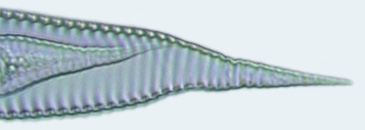 ......
Hemicycliophora ......
Hemicycliophora
|
16. (15) Annules
with cuticular spines or scales ...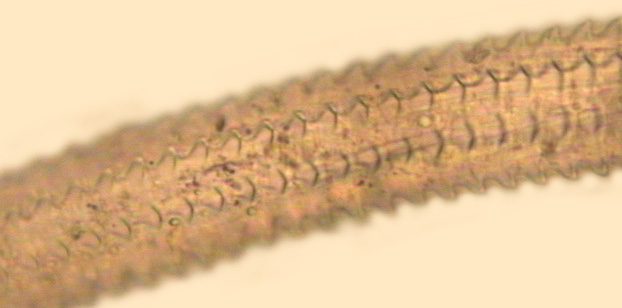 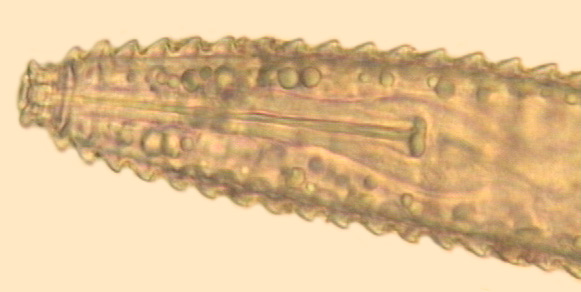 ..Criconema
Annules plain without spines
or scales . ..Criconema
Annules plain without spines
or scales .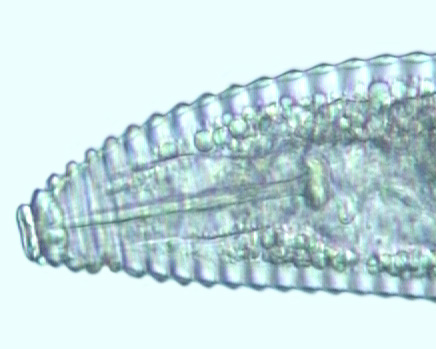 ...Mesocriconema ...Mesocriconema
|
17.
(14)
Body death position straight .. .18
Body death position spiral . .18
Body death position spiral . .....
Helicotylenchus
.....
Helicotylenchus
|
18. (17) Median esophageal
bulb distinct but not pronounced .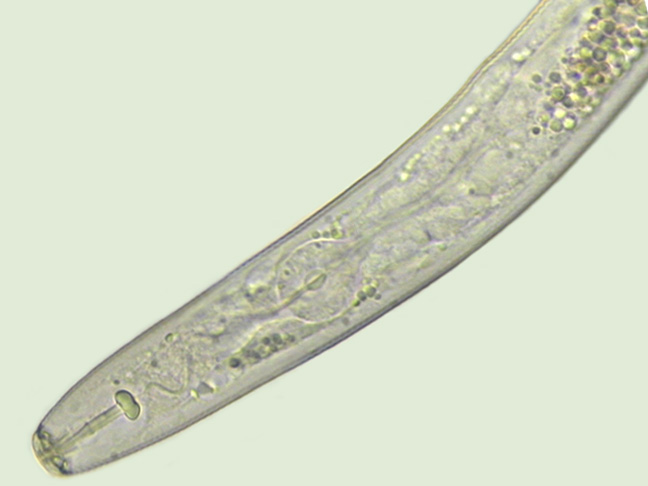 ...19
Median esophageal bulb well-developed
. ...19
Median esophageal bulb well-developed
.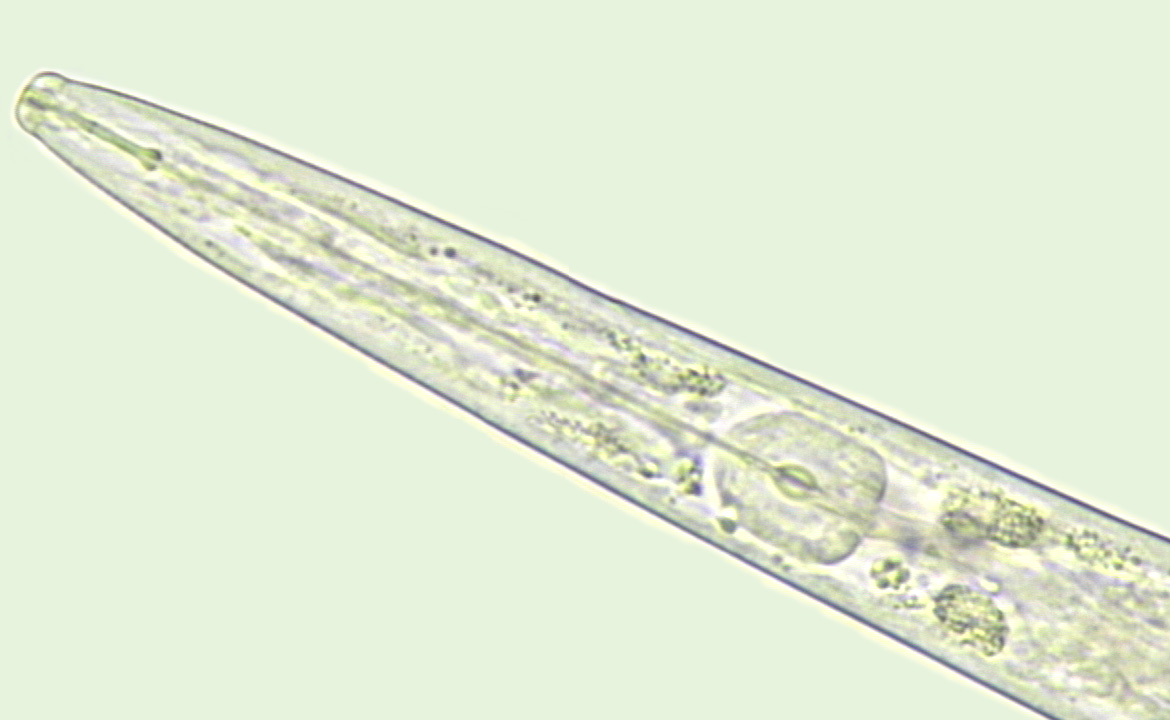 ...
Aphelenchoides ...
Aphelenchoides
|
19. (18) Esophagus
overlapping intestine .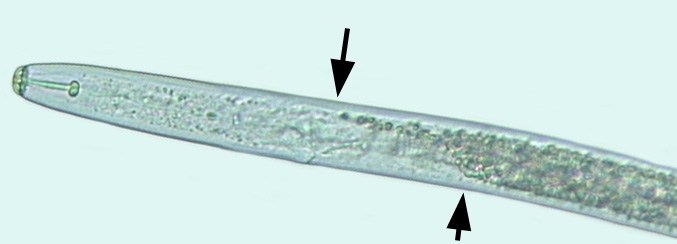 .....20
Esophagus not overlapping intestine
. .....20
Esophagus not overlapping intestine
.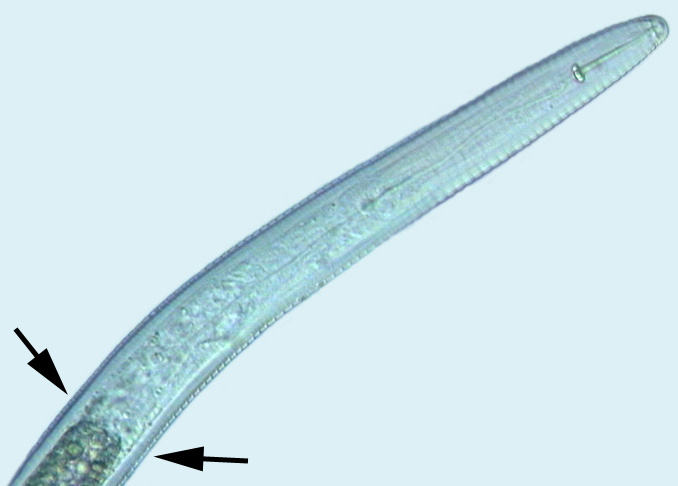 .....
Tylenchus .....
Tylenchus
|
20. (19) Median bulb
and valves small, stylet usually weak ..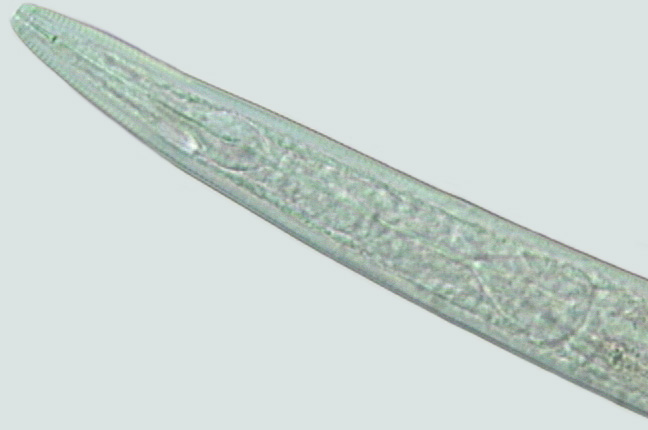 ....Ditylenchus
Median bulb valves and stylet
well developed, labium flattened . ....Ditylenchus
Median bulb valves and stylet
well developed, labium flattened . ......Pratylenchus ......Pratylenchus
|
21. (5) Female body
white without eggs . .....
Meloidogyne
Female body brown, usually with
eggs . .....
Meloidogyne
Female body brown, usually with
eggs .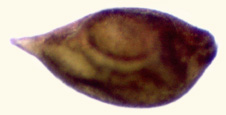 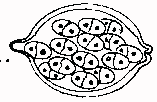 .....
Heterodera .....
Heterodera
|
22.
(4) Stylet short, less than 100 microns .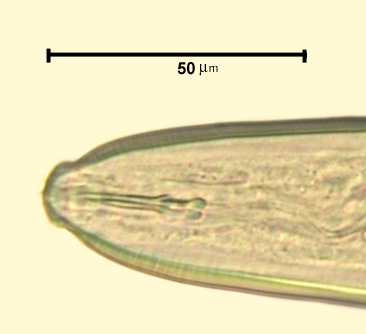 .....23 .....23
-
Stylet long, greater than 100
microns ..
 ......Xiphinema ......Xiphinema
|
23. (22) Stylet complex
.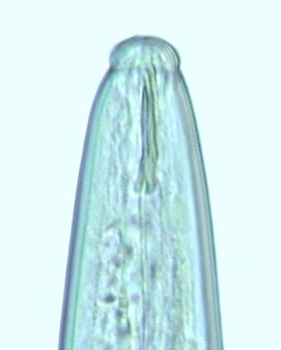 . .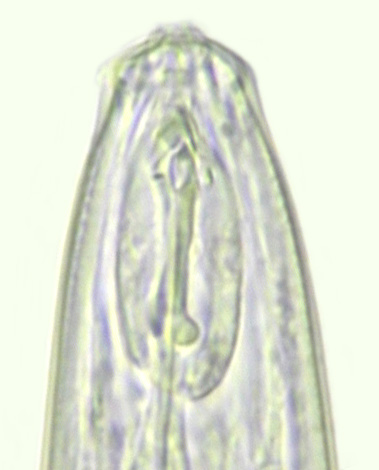 ..24
Stylet simple
. ..24
Stylet simple
. .....25 .....25
|
24. (23) Stylet with
anterior arch-like portion .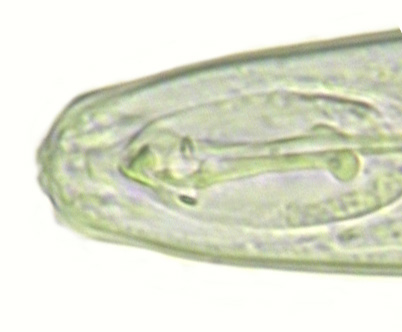 ...
Diphtherophora
Stylet with dorsal thickening
piece . ...
Diphtherophora
Stylet with dorsal thickening
piece .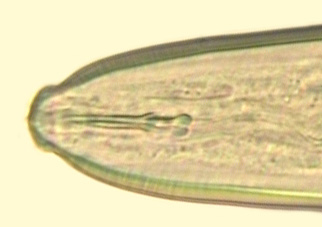 .....
Tylencholaimellus .....
Tylencholaimellus
|
25. (23) Stylet knobs
elongate, flange-like .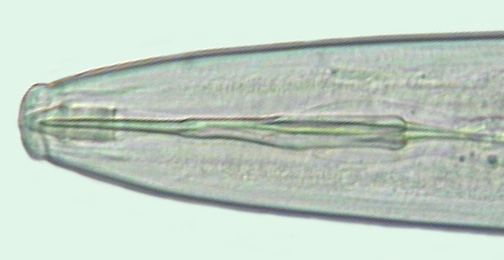 .....26
Stylet knobs round . .....26
Stylet knobs round .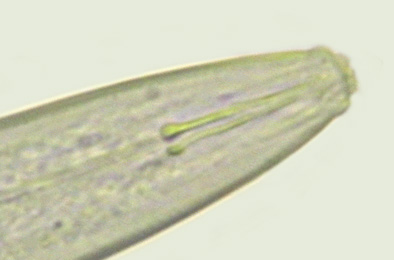 ....27 ....27
|
26. (25) Filiform
tail .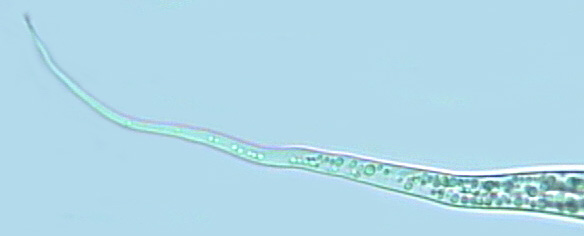 ...
Aulolaimoides
Round tail . ...
Aulolaimoides
Round tail .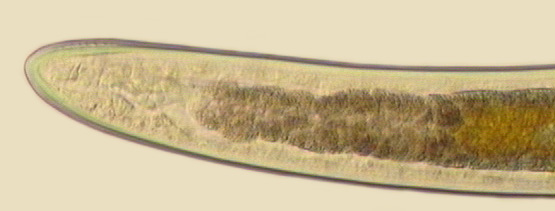 .....
Enchodelus .....
Enchodelus
|
27. (25) Tail rounded
.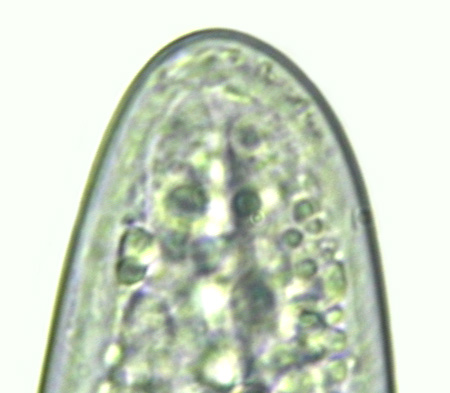 .....28
Tail pointed .. .....28
Tail pointed .. ........Nothotylenchus ........Nothotylenchus
|
28. (27) Basal part
esophagus elongate . .Tylencholaimus
Basal part esophagus oval ............. .Tylencholaimus
Basal part esophagus oval ............. .......Doryllium .......Doryllium
|
29.
(3) Valvate median esophageal bulb absent . .....30
Valvate median esophageal bulb
present .....30
Valvate median esophageal bulb
present  ....37 ....37
|
30. (29) Stomal walls
not cuticularized .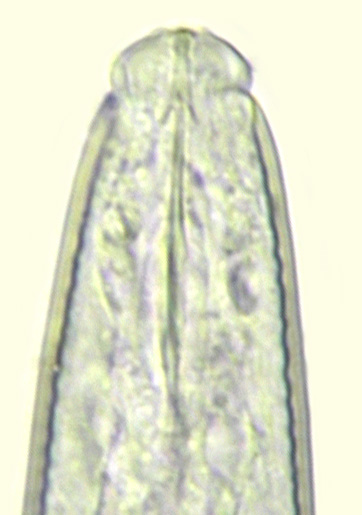 ....31
Stomal walls cuticularized ....31
Stomal walls cuticularized 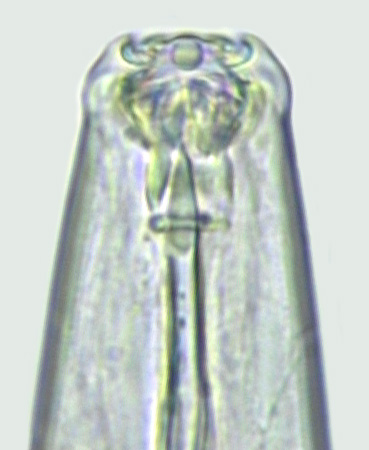 (Actinolaimus,
Metactinolaimus,
Neoactinolaimus,
Paractinolaimus)
..
Actinolaiminae (Actinolaimus,
Metactinolaimus,
Neoactinolaimus,
Paractinolaimus)
..
Actinolaiminae
|
31. (30) Esophagus
with basal expansions   ...32
Esophagus expanding uniformly
. ...32
Esophagus expanding uniformly
. ..
Oionchus ..
Oionchus
|
32. (31) Terminal
fifth or sixth of esophagus an ovoid bulb  ...33
Posterior third of esophagus
swollen . ...33
Posterior third of esophagus
swollen . ..36 ..36
|
33. (32) Stylet axial,
positioned centrally .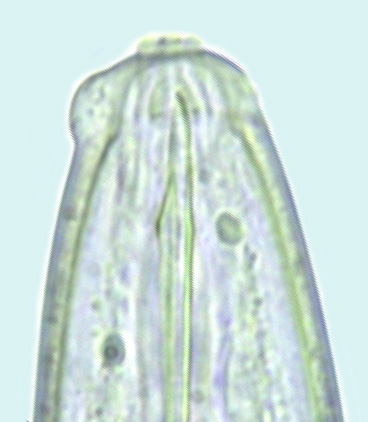 .....34
Stylet not axial orginating
from tooth in stoma wall . .....34
Stylet not axial orginating
from tooth in stoma wall .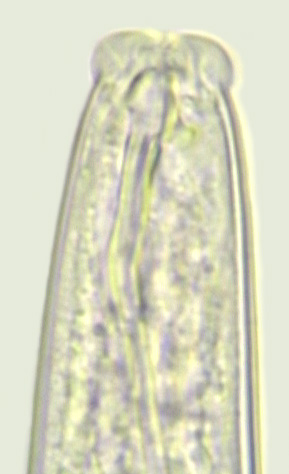 ......
Campydora ......
Campydora
|
34. (33) Gonads paired,
vulva usually near mid-body .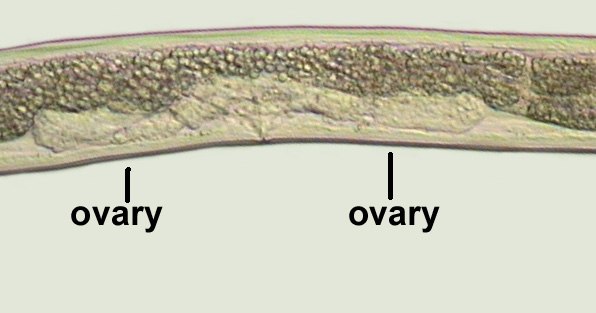 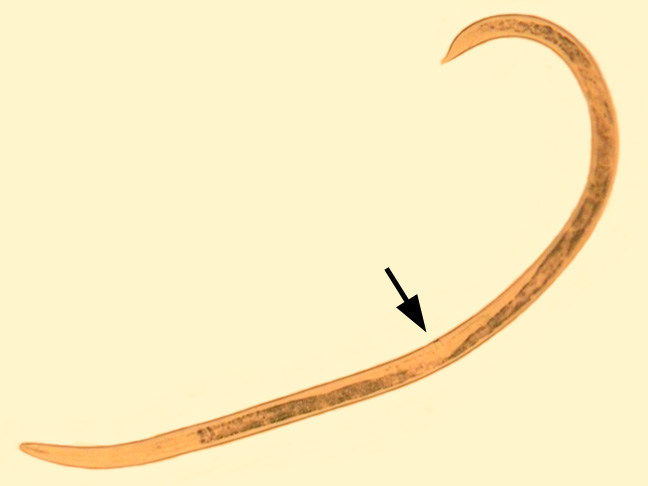 ..35
Gonads single, posterior to
vulva. Vulva usually anterior to mid-body . ..35
Gonads single, posterior to
vulva. Vulva usually anterior to mid-body .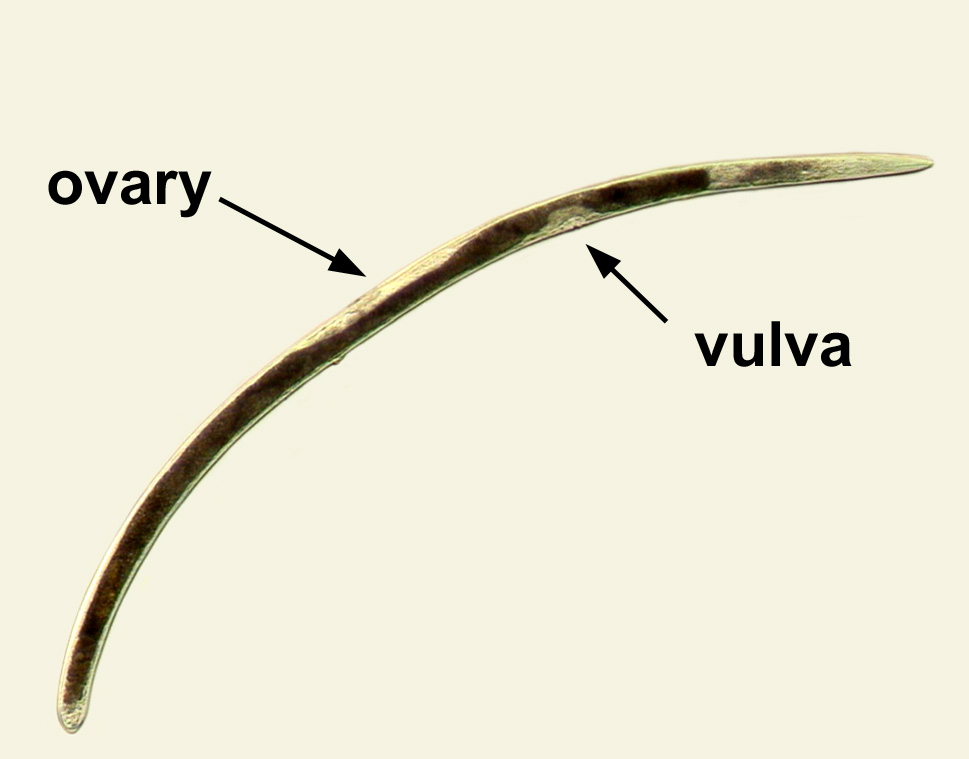 .....Tyleptus .....Tyleptus
|
35. (34) Stylet slender
.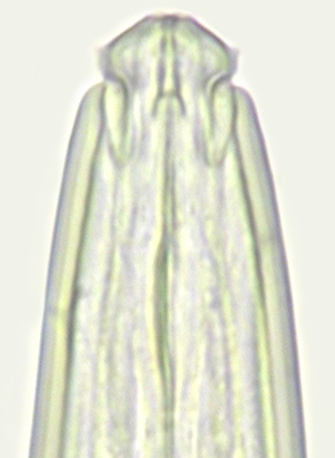 ..Leptonchus
Stylet not slender . ..Leptonchus
Stylet not slender .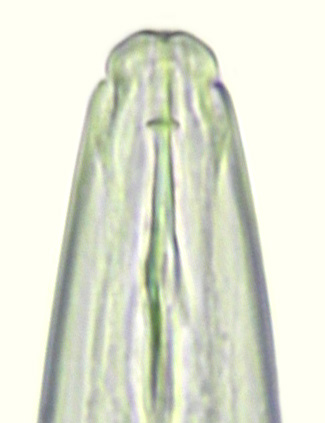 ..
Dorylaimoides ..
Dorylaimoides
|
36. (32) Stylet axial,
positioned centrally 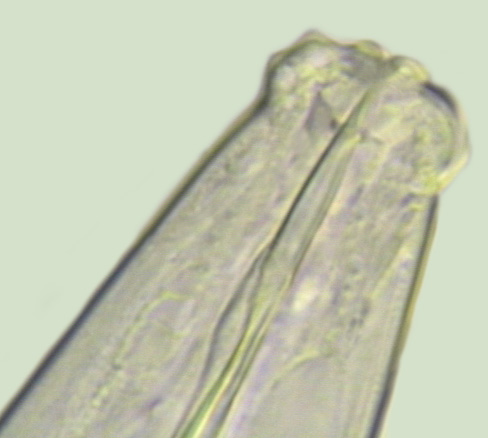 (Dorylaimus,
Eudorylaimus,
Labronema,Mesodorylaimus,
Thornia,
Laimydorus,
Prodorylaimus)
.. Dorylaiminae
Stylet not axial, originating
from tooth in stoma wall . (Dorylaimus,
Eudorylaimus,
Labronema,Mesodorylaimus,
Thornia,
Laimydorus,
Prodorylaimus)
.. Dorylaiminae
Stylet not axial, originating
from tooth in stoma wall .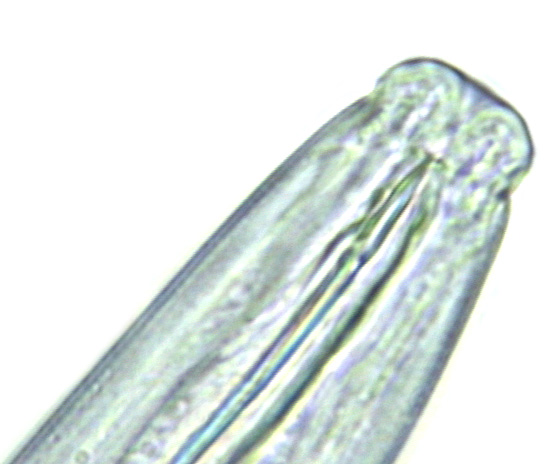 ..
Nygolaimus ..
Nygolaimus
|
37. (29) Tail pointed
. ..
Seinura
Tail rounded . ..
Seinura
Tail rounded .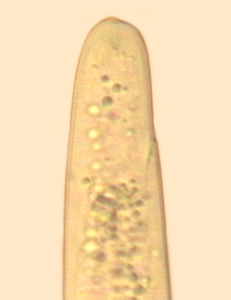 ......Aphelenchus ......Aphelenchus
|
38.
(2)
Teeth present, prominent .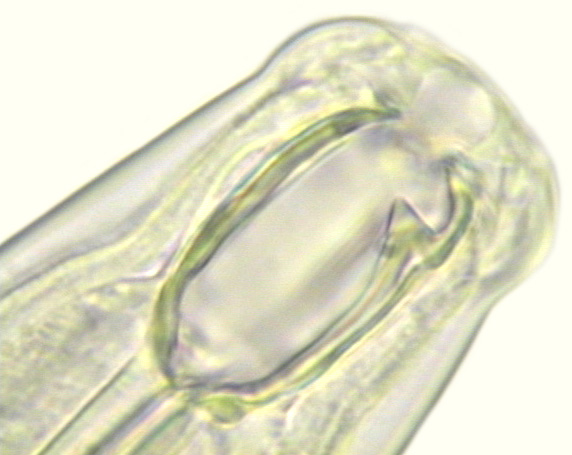 ...39
Teeth absent, minute, or indistinct
. ...39
Teeth absent, minute, or indistinct
.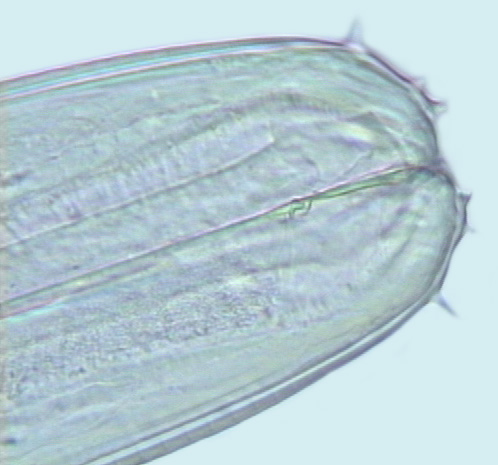 .....50 .....50
|
39. (38) Esophagus
without mid-region expansion  ......40
Esophagus expanded at mid-region
. ......40
Esophagus expanded at mid-region
.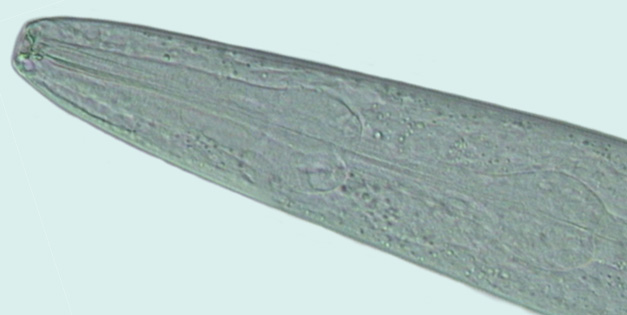 .....49 .....49
|
40. (39) Tail pointed
or tapering . .....41
Tail rounded.......................... .....41
Tail rounded..........................  ......47 ......47
|
41. (40) Male tail
without setae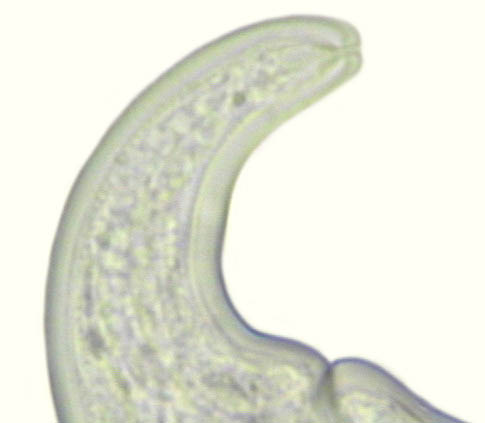 .....42
Male tail with setae . .....42
Male tail with setae . ..Oncholaimus ..Oncholaimus
|
42. (41) Stoma with
denticles 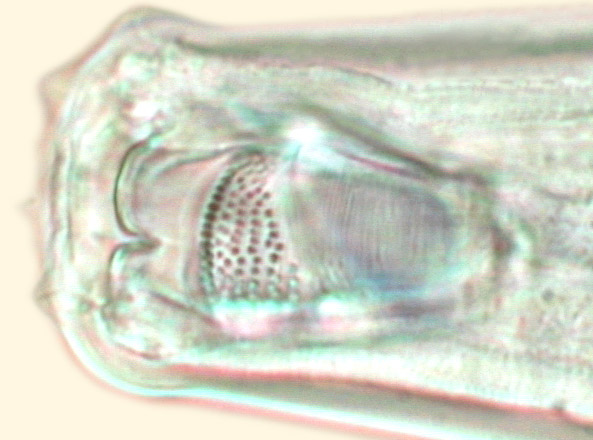 ......43
Stoma without denticles ....... ......43
Stoma without denticles .......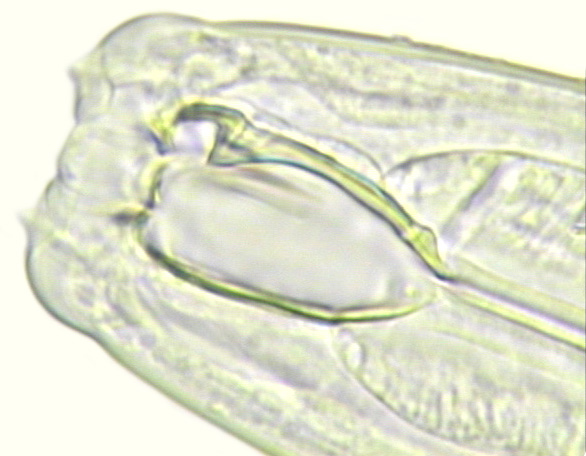 ....45 ....45
|
43. (42) Denticles
scattered or in longitudinal rows 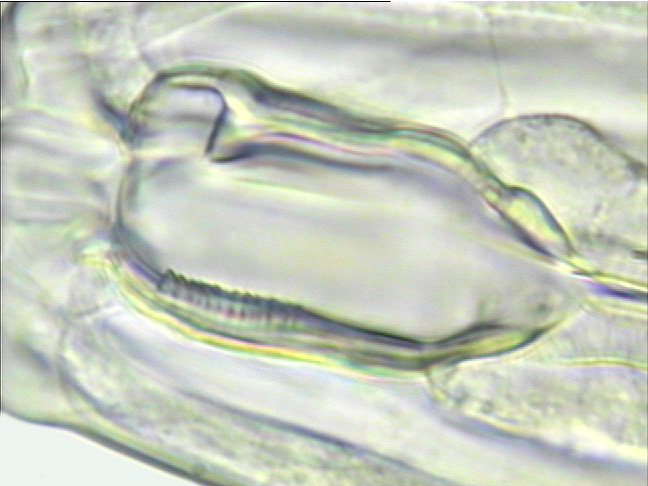 .....44
Denticles in transverse rows
. .....44
Denticles in transverse rows
. ...
Mylonchulus ...
Mylonchulus
|
44. (43) Denticles
situated on longitudinal rib of stoma .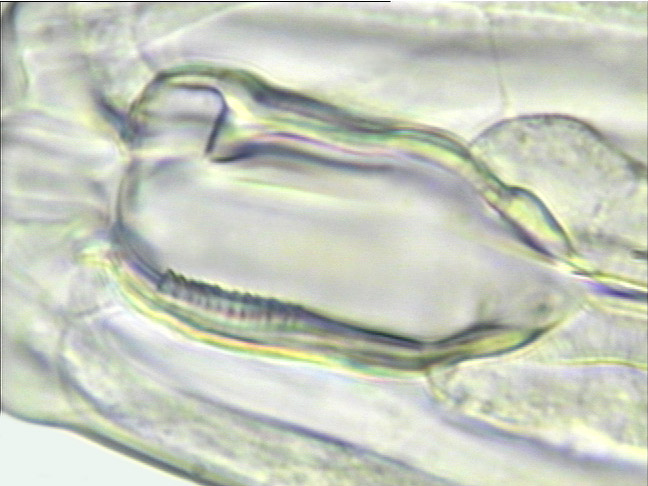 ...
Prionchulus
Denticles scattered on stoma
wall . ...
Prionchulus
Denticles scattered on stoma
wall . .....
Sporonchulus .....
Sporonchulus
|
45. (42) Tooth anteriorly
directed .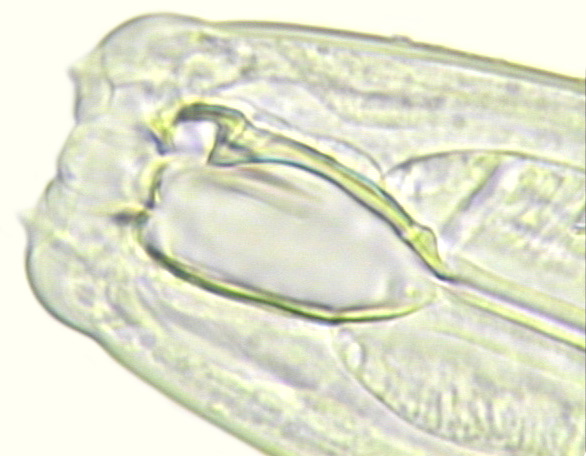 ..pic...46
Tooth retrorse . ..pic...46
Tooth retrorse . .....
Anatonchus .....
Anatonchus
|
46. (45) Tooth in
basal part of stoma .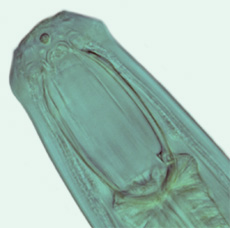 .........
Iotonchus
Tooth in anterior part of stoma .........
Iotonchus
Tooth in anterior part of stoma 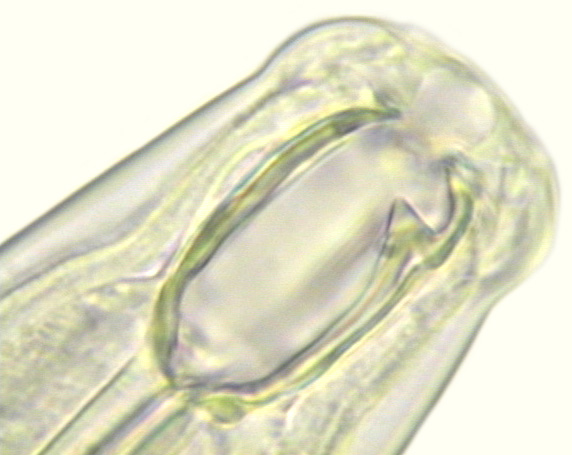 .....
Mononchus .....
Mononchus
|
47.
(40) Stoma with prominent medial or apical tooth . .....48
Stoma with small basal tooth .....48
Stoma with small basal tooth 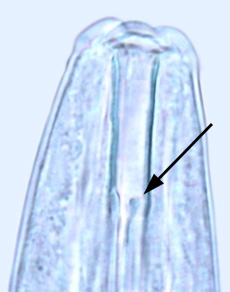 .....
Bathyodontus .....
Bathyodontus
|
48. (47) Stoma with
3 teeth, without small basal tooth, caudal glands terminal . ..
Enoplocheilus
Stoma with large anterior &
small basal tooth, caudal glands ventral . ..
Enoplocheilus
Stoma with large anterior &
small basal tooth, caudal glands ventral . ..
Mononchulus ..
Mononchulus
|
 ..2
..2
 .
64
.
64  ..69
..69 .3
.3

 ..38
..38
 .4
.4
 .29
.29 .5
.5
 ...22
...22 ..........6
..........6
 ..21
..21 ....7
....7
 ...14
...14 ....8
....8
 ....11
....11 .....9
.....9
 .....
Dolichodorus
.....
Dolichodorus  .....Quinisulcius
.....Quinisulcius
 .....10
.....10  ...
Psilenchus
...
Psilenchus
 ..
Tylenchorhynchus,
Merlinius,
Geocenamus (in part),
Scutylenchus,
Nagelus
..
Tylenchorhynchus,
Merlinius,
Geocenamus (in part),
Scutylenchus,
Nagelus ...12
...12
 .
. ....13
....13 ..
Hoplolaimus
..
Hoplolaimus
 ..
Belonolaimus
..
Belonolaimus .....
Radopholus
.....
Radopholus
 .15
.15
 ....17
....17 ..........Paratylenchus
..........Paratylenchus ..
16
..
16
 ......
Hemicycliophora
......
Hemicycliophora 
 ..Criconema
..Criconema
 ...Mesocriconema
...Mesocriconema .18
.18
 .....
Helicotylenchus
.....
Helicotylenchus ...19
...19
 ...
Aphelenchoides
...
Aphelenchoides  .....20
.....20
 .....
Tylenchus
.....
Tylenchus  ....Ditylenchus
....Ditylenchus
 ......Pratylenchus
......Pratylenchus .....
Meloidogyne
.....
Meloidogyne

 .....
Heterodera
.....
Heterodera .....23
.....23
 .
. ..24
..24
 .....25
.....25 ...
Diphtherophora
...
Diphtherophora
 .....
Tylencholaimellus
.....
Tylencholaimellus  .....26
.....26
 ....27
....27 ...
Aulolaimoides
...
Aulolaimoides
 .....
Enchodelus
.....
Enchodelus  .....28
.....28
 ........Nothotylenchus
........Nothotylenchus  .Tylencholaimus
.Tylencholaimus
 .......Doryllium
.......Doryllium  .....30
.....30
 ....37
....37 ....31
....31
 (Actinolaimus,
Metactinolaimus,
Neoactinolaimus,
Paractinolaimus)
..
Actinolaiminae
(Actinolaimus,
Metactinolaimus,
Neoactinolaimus,
Paractinolaimus)
..
Actinolaiminae 
 ...32
...32
 ..
Oionchus
..
Oionchus  ...33
...33
 ..36
..36 .....34
.....34
 ......
Campydora
......
Campydora 
 ..35
..35
 .....Tyleptus
.....Tyleptus  ..Leptonchus
..Leptonchus
 ..
Dorylaimoides
..
Dorylaimoides  (Dorylaimus,
Eudorylaimus,
Labronema,Mesodorylaimus,
Thornia,
Laimydorus,
Prodorylaimus)
.. Dorylaiminae
(Dorylaimus,
Eudorylaimus,
Labronema,Mesodorylaimus,
Thornia,
Laimydorus,
Prodorylaimus)
.. Dorylaiminae
 ..
Nygolaimus
..
Nygolaimus  ..
Seinura
..
Seinura
 ......Aphelenchus
......Aphelenchus  ...39
...39
 .....50
.....50 ......40
......40
 .....49
.....49 .....41
.....41
 ......47
......47  .....42
.....42
 ..Oncholaimus
..Oncholaimus  ......43
......43
 ....45
....45 .....44
.....44
 ...
Mylonchulus
...
Mylonchulus  ...
Prionchulus
...
Prionchulus
 .....
Sporonchulus
.....
Sporonchulus  ..pic...46
..pic...46
 .....
Anatonchus
.....
Anatonchus  .........
Iotonchus
.........
Iotonchus
 .....
Mononchus
.....
Mononchus  .....48
.....48
 .....
Bathyodontus
.....
Bathyodontus  ..
Enoplocheilus
..
Enoplocheilus
 ..
Mononchulus
..
Mononchulus 